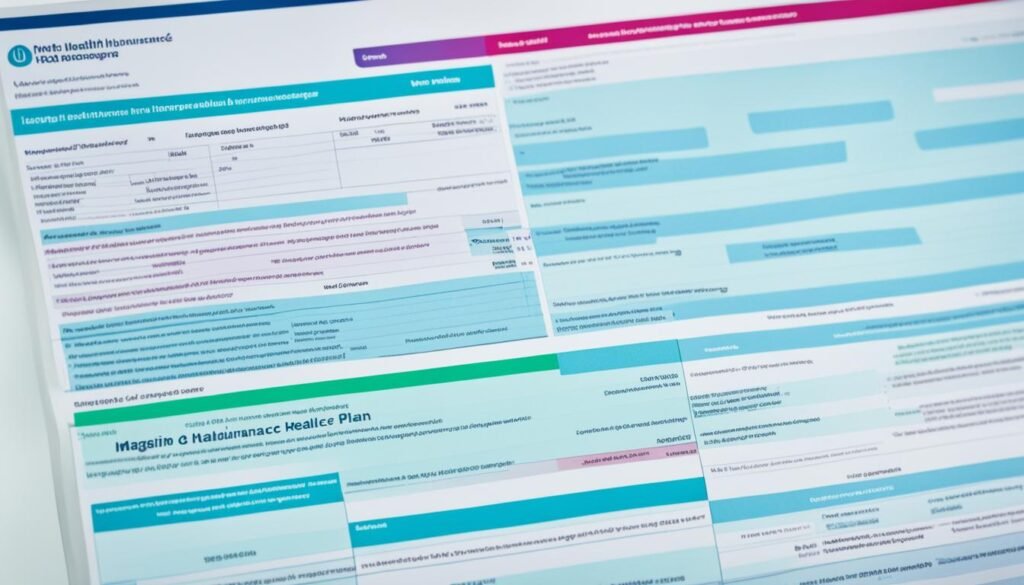Welcome to our guide on the best individual health insurance plans for 2024! Having the right health insurance coverage is crucial for maintaining your well-being and managing healthcare costs. In this article, we will explore different individual health insurance options, highlight affordable plans, and provide insights on finding the best coverage that suits your needs and budget.
When searching for individual health insurance plans, it’s essential to consider factors such as cost, coverage options, and subsidies. By understanding these elements, you can make an informed decision that ensures you have the necessary protection without breaking the bank.
Key Takeaways: Best Individual Health Insurance
- Compare individual health insurance plans to find the best option for your needs and budget.
- Affordable health insurance plans are available through the Affordable Care Act (ACA) marketplace.
- Consider bronze and silver plans, as they typically have lower premiums.
- Check if you qualify for subsidies or tax credits, as they can significantly reduce your overall health insurance costs.
- Ensure that your preferred doctors and healthcare providers accept the plan you choose.
Average Cost of Health Insurance by Age
When exploring health insurance options, it’s important to consider how age affects the cost of coverage. The average monthly cost of health insurance in the ACA marketplace varies based on age and plan type. Let’s take a closer look at the average costs for different age groups:
21-Year-Old
For a 21-year-old, the average monthly cost of health insurance is as follows:
| Plan Type | Average Monthly Cost |
|---|---|
| Bronze | $397 |
| Silver | $444 |
| Gold | $348 |
| Platinum | $396 |
60-Year-Old
As individuals grow older, the cost of health insurance tends to increase. Here are the average monthly costs for a 60-year-old:
| Plan Type | Average Monthly Cost |
|---|---|
| Bronze | $1,079 |
| Silver | $1,206 |
| Gold | $946 |
| Platinum | $1,076 |
It’s important to note that these average costs are based on unsubsidized ACA plans and do not include deductibles or other out-of-pocket expenses. Your actual costs may vary based on factors such as your location, income, and specific plan details.
Understanding the average cost of health insurance by age can help you make informed decisions when selecting a plan that fits your budget and coverage needs. Consider comparing quotes from different insurance providers and exploring available subsidies to find the most affordable option for you.
Average Monthly Health Insurance Costs by Tier

The average monthly costs of health insurance plans can vary depending on the metal tier. Health insurance plans are categorized into bronze, silver, gold, and platinum tiers, each offering different levels of coverage and cost.
For a 27-year-old, the average monthly cost of a health insurance plan is as follows:
- Bronze plan: $345
- Silver plan: $452
- Gold plan: $585
These average costs are based on unsubsidized health insurance plans available through the Affordable Care Act (ACA) marketplace. It’s important to note that actual costs may vary depending on factors such as location, specific plan details, and individual health needs.
The bronze plan, being the most affordable tier, generally has higher deductibles and out-of-pocket costs. Silver plans offer a balance between cost and coverage, while gold plans provide more comprehensive coverage with higher premiums. The platinum tier offers the highest level of coverage but comes with the highest monthly costs.
“Understanding the cost variations across metal tiers is crucial in choosing a health insurance plan that fits your budget and healthcare needs.”
It’s important to consider your own financial situation, healthcare requirements, and risk tolerance when deciding on a metal tier. While the bronze plan may have lower monthly costs, it may result in higher out-of-pocket expenses if you need more healthcare services. Conversely, the platinum plan may have higher monthly costs but can provide more comprehensive coverage.
Factors Affecting Health Insurance Costs
Several factors can influence the cost of health insurance, including:
- Age: Older individuals generally pay higher premiums.
- Location: Health insurance costs can vary depending on where you live.
- Health: Pre-existing conditions or health risks may affect premiums.
- Provider Network: Plans with larger provider networks may have higher costs.
- Deductibles and Copayments: Higher deductibles and copayments can reduce monthly costs but increase out-of-pocket expenses.
Understanding these factors and how they impact cost can help you make informed decisions when selecting a health insurance plan.
Get Subsidies if You Can

Subsidies are available for individuals purchasing health insurance through the ACA marketplace. These subsidies can significantly lower the overall cost of health insurance premiums. To qualify for subsidies, individuals must have a household income below 400% of the federal poverty level. It is recommended to take advantage of these subsidies to make health insurance more affordable.
When purchasing health insurance through the ACA marketplace, it’s important to consider the potential benefits of health insurance subsidies. These subsidies can help reduce your health insurance costs, making it more affordable for you and your family.
“Health insurance subsidies provided through the ACA marketplace can be a game-changer for individuals and families seeking affordable coverage. They are designed to help lower-income individuals access the healthcare they need without overwhelming financial burdens. If you qualify for subsidies, be sure to take advantage of them to reduce your health insurance costs and make healthcare more affordable.”
Health insurance subsidies are based on your household income and can significantly reduce the cost of your monthly premiums. By applying for subsidies and receiving financial assistance, you can ensure that you have access to the healthcare coverage you need while keeping your costs manageable.
How Health Insurance Subsidies Work
Health insurance subsidies are provided by the government to help individuals and families with lower incomes afford health insurance. The amount of the subsidy is based on a person’s income and household size, and it is applied directly to their monthly health insurance premiums.
When you apply for health insurance through the ACA marketplace, you will be asked to provide information about your income and household size. This information is used to determine if you are eligible for subsidies and how much financial assistance you qualify for.
Once you are approved for health insurance subsidies, the subsidy amount will be applied to your monthly health insurance premiums. This means that you will pay a lower monthly premium, making your health insurance more affordable.
It’s important to note that the availability of health insurance subsidies can vary based on your state and individual circumstances. It’s recommended to check the eligibility criteria for subsidies in your state and consult with a certified enrollment counselor or insurance agent to understand your specific subsidy options.
Accessing Health Insurance Subsidies
To access health insurance subsidies, you will need to purchase health insurance through the ACA marketplace during the open enrollment period. The open enrollment period usually occurs once a year, but there may also be special enrollment periods available due to qualifying life events such as getting married, having a baby, or losing other health coverage.
During the application process, you will be able to indicate that you are interested in receiving health insurance subsidies. The marketplace will then determine if you are eligible based on your income and household size.
If you qualify for health insurance subsidies, you will receive an estimate of the financial assistance you will receive. This estimate will show how much your monthly premiums will be reduced.
Once you have enrolled in a health insurance plan and have been approved for subsidies, you can start using your health insurance with the reduced monthly premium. It’s important to continue reporting any changes in your income or household size throughout the year, as this may affect your subsidy eligibility or amount.
By taking advantage of health insurance subsidies, you can significantly reduce the cost of your health insurance premiums and make healthcare more affordable for you and your family.
| Household Size | Annual Income Limit for Subsidies | Approximate Subsidy Range |
|---|---|---|
| 1 | $51,040 | $0 – $12,760 |
| 2 | $68,960 | $0 – $17,240 |
| 3 | $86,880 | $0 – $21,720 |
| 4 | $104,800 | $0 – $26,200 |
| 5 | $122,720 | $0 – $30,680 |
Compare Quotes

When shopping for health insurance, it is important to compare quotes from different insurance providers. This allows you to assess the costs and benefits of various plans and make an informed decision when choosing the right coverage for you and your family.
The Affordable Care Act (ACA) marketplace website provides a convenient tool to compare health insurance plans based on their metal tiers, which categorize plans according to their coverage levels and costs. By comparing plans in the same metal tier, you can have a more accurate understanding of the differences in costs and benefits.
For instance, let’s take a look at the average monthly costs of different metal tier plans for a 30-year-old individual:
| Metal Tier | Average Monthly Cost |
|---|---|
| Bronze | $365 |
| Silver | $425 |
| Gold | $500 |
| Platinum | $600 |
By comparing the costs of different metal tiers, you can identify which plans are more affordable and suitable for your budget.
It is important to note that while cost is an essential factor in choosing health insurance, it is equally crucial to consider the coverage and benefits offered by each plan. Review the deductibles, copayments, and out-of-pocket maximums to ensure that the plan provides the necessary coverage for your healthcare needs.
Remember, finding affordable health insurance is not just about comparing costs. It’s about finding a balance between cost and coverage to ensure you have the appropriate protection for your health and well-being.
Once you have compared quotes from different insurance providers, you can narrow down your options and select a plan that fits your budget and meets your specific healthcare needs. This careful comparison can help you find affordable health insurance options that provide the coverage you require.
By taking the time to compare quotes, you can confidently find an insurance policy that not only fits your budget, but also provides the coverage and peace of mind you need for a healthy future.
Consider an HMO or EPO

When exploring health insurance options, it’s important to consider Health Maintenance Organization (HMO) or Exclusive Provider Organization (EPO) plans. These plan types have gained popularity due to their potential for lower premiums and comprehensive coverage.
An HMO plan operates using a network of healthcare providers, including doctors, specialists, hospitals, and pharmacies. By choosing an HMO plan, individuals gain access to a specific network of healthcare professionals. This type of plan typically requires individuals to select a primary care physician (PCP) who manages their healthcare and refers them to specialists when needed.
On the other hand, an EPO plan also utilizes a network of healthcare providers but does not require a PCP or referrals to see specialists. Like an HMO, an EPO offers comprehensive coverage within the designated network. However, it’s crucial to note that EPO plans do not typically cover out-of-network care, except in emergencies.
One of the significant advantages of HMO and EPO plans is their potential for lower premiums compared to other health insurance plan types. The limited network helps reduce costs and often results in more affordable monthly premiums.
Choosing an HMO or EPO plan can be a cost-effective option, especially for individuals searching for more affordable health insurance. These plans promote a coordinated approach to healthcare within a designated network, allowing individuals to receive the care they need at a more affordable price.
“HMO and EPO plans provide comprehensive coverage within a network of healthcare providers, offering a cost-effective option for individuals seeking affordable health insurance.”
To understand how HMO and EPO plans compare to other options, it’s important to consider factors such as network coverage, cost-sharing requirements, and individual healthcare needs. By evaluating these elements, individuals can make an informed decision about the best health insurance plan for themselves and their families.
Comparison of HMO and EPO Plans
| Features | HMO | EPO |
|---|---|---|
| Network Requirement | Requires individuals to select a primary care physician (PCP) and obtain referrals for specialist care | Does not require a primary care physician (PCP) or referrals for specialist care |
| Out-of-Network Coverage | Typically does not cover out-of-network care, except in emergencies | Does not cover out-of-network care, except in emergencies |
| Premiums | Potential for lower premiums due to the limited network | Potential for lower premiums due to the limited network |
| Cost-Sharing | May have lower out-of-pocket costs for in-network care | May have lower out-of-pocket costs for in-network care |
| Flexibility | Requires individuals to stay within the network for most healthcare services | Requires individuals to stay within the network for most healthcare services |
When considering an HMO or EPO plan, it’s crucial to review the specific details of each plan offered by insurance providers. The table above provides an overview comparison, but individual plan details may vary. This comparison helps highlight the key differences between HMO and EPO plans to assist individuals in making an informed decision based on their preferences and healthcare needs.
To learn more about HMO and EPO health insurance plans and compare the offerings of different insurance providers, visit their official websites and consult with insurance professionals.
Make Sure Your Doctors Take the Plan

Before purchasing a health insurance plan, it is crucial to verify that your preferred doctors and healthcare providers are accepted by the plan. To avoid any issues, it is highly recommended to directly confirm with the providers themselves. Relying solely on the online provider directory provided by the insurance company can lead to outdated or incorrect information, potentially causing inconvenience or even treatment denials.
“It is always prudent to double-check with your doctors and healthcare providers to ensure they are in-network and accept the specific health insurance plan you are considering. Online provider directories may not always be up-to-date, and it’s essential to have accurate information to make informed decisions about your healthcare.”
– Dr. Elizabeth Roberts, Chief Medical Officer at HealthNet
By directly contacting your doctors, you can ascertain whether they are part of the health insurance provider network and accept the plan you’re interested in. Remember, each insurance plan has a network of healthcare providers, and going out-of-network may result in higher out-of-pocket costs or denial of coverage, depending on the plan’s terms and conditions.
If you have a specific doctor or healthcare facility in mind, it’s worth confirming their network participation before finalizing your health insurance decision. Be proactive in seeking this information and make sure all your preferred doctors are in-network to ensure seamless access to the necessary medical services.
To simplify the process, many health insurance companies offer online provider directories. While these directories can provide a starting point, they should not be the sole source of information. Keep in mind that there might be delays in updating the online directories, which can lead to inaccurate or outdated information.
By taking the time to verify that your doctors and healthcare providers are accepted by the plan, you can avoid unexpected surprises and ensure that you have access to the healthcare services you need, when you need them.
Get on a Spouse or Parent’s Plan

Joining a spouse or parent’s health insurance plan can be a cost-effective option, especially if the employer contributes to the premium. This can help individuals save on the cost of health insurance and still access the necessary coverage. It is advised to review all available health insurance options, including family plans, before making a decision.
When considering family health insurance plans, individuals can explore the option of joining their spouse or parent’s plan. This can offer several advantages, including potential cost savings and simplified enrollment.
Many employers offer health insurance coverage to their employees and their immediate family members, including spouses and children. By getting on a spouse’s plan, individuals can benefit from the group rate offered by the employer, which is often more affordable than individual health insurance plans.
Additionally, some employers contribute to a portion of the health insurance premium, reducing the financial burden further. This employer contribution can significantly lower the cost of health insurance for the entire family.
Joining a parent’s health insurance plan is also a viable option for young adults who are under the age of 26. This provision in the Affordable Care Act allows individuals to stay on their parents’ health insurance plan, even if they are married or financially independent.
Before deciding to get on a spouse or parent’s plan, it is important to carefully review the coverage and benefits offered. Consider factors such as network providers, deductible amounts, out-of-pocket costs, and prescription drug coverage. Ensure that the plan meets the health needs of all family members and provides access to preferred doctors and specialists.
It is advisable to consult with the spouse or parent whose plan you intend to join and discuss the coverage details, costs, and any potential limitations. This open communication will ensure that everyone is on the same page and that the health insurance plan aligns with the family’s needs.
Ultimately, joining a spouse or parent’s health insurance plan can be a smart decision for individuals looking for cost-effective family health insurance options. By taking advantage of employer-sponsored plans and understanding the coverage specifics, individuals can save money while still accessing comprehensive healthcare services.
| Advantages of Getting on a Spouse or Parent’s Plan | Considerations |
|---|---|
|
|
Compare the Best Cheap Health Insurance Companies

When it comes to finding affordable health insurance, it’s important to consider the best options available. Several health insurance companies offer plans that are both cost-effective and provide comprehensive coverage. If you’re looking for the best cheap health insurance companies, here are some top options:
- Kaiser Permanente: Known for its strong network of healthcare providers and quality ratings, Kaiser Permanente offers affordable health insurance plans with various coverage options.
- Aetna: Aetna is another reputable health insurance provider offering affordable plans. With a wide range of options and competitive pricing, Aetna is a popular choice for individuals seeking affordable coverage.
- UnitedHealthcare: UnitedHealthcare is known for its diverse range of health insurance plans and strong customer satisfaction ratings. It offers affordable options that cater to different needs and budgets.
These companies have been rated highly based on factors such as cost, consumer complaints, quality ratings, and variety of health insurance plans. By comparing quotes from these top cheap health insurance companies, you can find the best and most affordable insurance options for your specific needs and budget.
Factors to Consider When Comparing Health Insurance Companies
When comparing health insurance companies, it’s essential to evaluate various factors to make an informed decision:
- Cost: Compare the premiums, deductibles, and out-of-pocket costs of different plans to ensure they align with your budget.
- Provider Network: Check if your preferred doctors and healthcare providers are included in the company’s network to ensure accessibility and convenience.
- Coverage Options: Assess the range of coverage options available, including services such as prescription drugs, specialist visits, and preventive care.
- Customer Satisfaction: Research customer reviews and ratings to gauge the overall satisfaction levels of policyholders.
- Additional Benefits: Consider any additional benefits provided by the insurance company, such as wellness programs or telemedicine services.
Taking these factors into account will help you make an informed decision and secure the best cheap health insurance that meets your needs.
| Insurance Company | Cost | Provider Network | Coverage Options | Customer Satisfaction |
|---|---|---|---|---|
| Kaiser Permanente | Affordable | Strong network | Comprehensive coverage | High ratings |
| Aetna | Competitive pricing | Wide network | Various options | Positive reviews |
| UnitedHealthcare | Cost-effective | Diverse network | Flexible coverage | Excellent satisfaction |
How to Get Affordable Health Insurance
There are several ways to obtain affordable health insurance. One option is to enroll in a group health insurance plan offered by your employer, as these plans are often cheaper than individual health insurance. Another option is to explore the Health Insurance Marketplace, which offers low-cost health insurance plans, especially for individuals who qualify for health insurance subsidies or have a low income. Medicaid is another option for individuals with a low income, offering comprehensive coverage at little or no cost. It is also worth considering direct purchase from a health insurance company, but be sure to review and compare the benefits and coverage to find the best fit for your needs.
Options for Affordable Health Insurance
- Group Health Insurance Plan
- Health Insurance Marketplace
- Medicaid
- Direct Purchase
When it comes to finding affordable health insurance options, it’s important to consider your specific needs and budget. Here are some details about each option:
| Option | Description | Key Benefits |
|---|---|---|
| Group Health Insurance Plan | Offered through your employer | Lower premiums, employer contributions |
| Health Insurance Marketplace | Online platform for shopping and comparing plans | Low-cost plans, subsidies for eligible individuals |
| Medicaid | Government program for low-income individuals | Comprehensive coverage at little or no cost |
| Direct Purchase | Buying a plan directly from an insurance company | Customizable options, variety of coverage levels |
By exploring these options, you can find low-cost health insurance that fits your needs and budget. Remember to compare quotes, review coverage details, and consider any available health insurance subsidies to make the most informed decision for your healthcare needs.
Also Read : Building A Secure Future State Farm Home Insurance
Conclusion
Finding the best individual health insurance plan involves considering various factors such as cost, coverage options, and subsidies. It is important to compare quotes, research different health insurance companies, and consider your specific needs and budget. Affordable health coverage is available through the ACA marketplace, group health insurance plans, and other options. Personalized health insurance options can help individuals find the coverage that best suits their needs. By exploring different options and considering all factors, individuals can find the right individual health insurance plan for themselves and their families.
FAQs
Q: What is the Affordable Care Act and how does it impact individual health insurance plans?
A: The Affordable Care Act, also known as Obamacare, introduced reforms to the health insurance industry, making it easier for individuals to find affordable health insurance plans through the health insurance marketplace.
Q: What are some options for family health insurance plans in 2024?
A: In 2024, families can choose from a variety of health insurance plan options including marketplace plans, ACA health plans, and high-deductible health plans to ensure coverage for their loved ones.
Q: How can I find the cheapest health insurance plan for myself?
A: To find the most affordable health insurance plan, it’s important to compare health insurance quotes, consider different plan options, and explore the marketplace for individual and family health insurance plans that meet your budget and needs.
Q: What are some key factors to consider when choosing an individual or family health insurance plan?
A: When selecting a health plan, look at factors such as the coverage it provides, health care services included, if it covers essential health benefits, and whether it offers a health savings account option.
Q: When should I start looking for individual health insurance coverage for the upcoming year?
A: It’s advisable to start looking for individual health insurance plans at least a year before your current plan ends to ensure a smooth transition and avoid any gaps in coverage.
Q: How do bronze and silver health insurance plans differ?
A: Bronze health insurance plans typically have lower premiums but higher out-of-pocket costs, while silver health insurance plans have slightly higher premiums and more coverage for health care services.
Q: What are the essential health benefits that individual health insurance plans must cover?
A: Under the Affordable Care Act, individual health insurance plans are required to cover essential health benefits such as preventive care, prescription drugs, maternity care, and mental health services.
Source Links
- https://www.forbes.com/advisor/health-insurance/best-affordable-health-insurance/
- https://www.usatoday.com/money/blueprint/health-insurance/best-cheap-health-insurance/
- https://www.opm.gov/healthcare-insurance/healthcare/plan-information/compare-plans/




